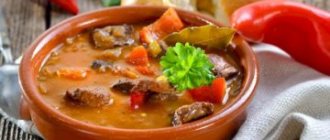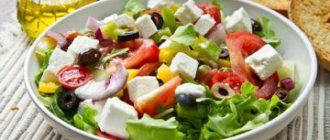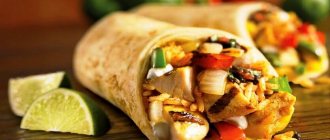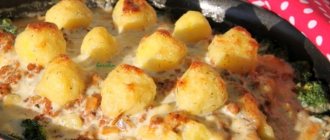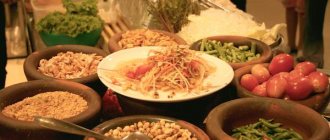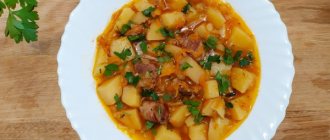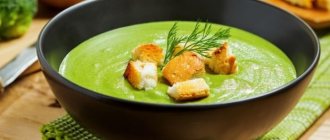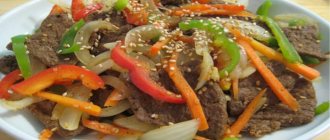In order not to become like the good soldier Schweik, who knew only Debrecen sausages from the whole variety of Hungarian cuisine, you need to know in advance what Hungarian chefs can please you with.
Then, when traveling to Hungary, the complex Magyar names of dishes will not put you in a slight stupor. Traditional Hungarian cuisine
The cuisine, which the whole world knows as Hungarian, is a barbaric mixture of typical European, Jewish (many Jews lived in this country until the 20th century) and Turkish, since Hungary was under Ottoman rule for quite a long time.
The Hungarians themselves are categorical in their assessment of their cuisine; a tasty local dish, first of all, should be fatty, spicy with a lot of paprika and onions. The most common local dishes combine the properties of rich soup and meat in vegetable sauce. This versatility is due to the fact that these dishes date back to the Middle Ages, when it was not customary to use a large number of pots when preparing dinner.
Goulash
The main national Hungarian meat dish is thick goulash. Initially, it was a traditional food for shepherds; soup was cooked over a fire in pots. The word “goulash” itself is translated from Hungarian as “shepherd”. Now, without exaggeration, the dish can be eaten in every restaurant in Budapest.
7 places in Budapest that serve the most delicious goulash
Pieces of veal or beef are fried and then stewed with potatoes, onions and slices of smoked bacon. Mandatory additives are paprika and cumin, which make the food especially tasty and aromatic.
At the beginning of September, the national Goulash Festival is held in the town of Szolnok, 90 km from Budapest. The dish is prepared right in the open air in thousands of cauldrons. There are a lot of people who want to try the aromatic soup, but no one has ever left hungry: there is enough goulash for everyone!
In Budapest, you can eat excellent goulash at Parisi, 6 (Parizsi utca, 6b), Castro Bistro (Madach Imre ter. 3) or at For Sale Pub (Vamhaz koerut, 2).
Tips for visiting Budapest: how to get there, where to live, what to see, food, excursions, walking route, mobile Internet, baths, etc.
Bograch (bogrács)
Soups take pride of place in Hungarian cuisine. Not a single meal is complete without them, and local chefs never tire of competing in their preparation. Bograc is another incredibly delicious soup, the recipe of which was once borrowed from Hungarian shepherds.
The dish necessarily includes meat products and a lot of vegetables: sweet peppers, potatoes, carrots, tomatoes, onions. Even in inexpensive cafes in Budapest you can eat bograch with both beef and smoked meats (pork ribs, hunting sausages).
>>> Car rental in Europe. Secrets of profitable rentals, features and Lifehacks <<
The main “highlight” of the soup is chipetke (this word translated from Hungarian means “to pinch”) . They knead the dough from eggs and flour, then lightly dry it in the oven or in a frying pan, pinch off small pieces and throw them into the soup (it turns out something like dumplings or Ukrainian dumplings).
In Budapest, you can try bograc and other delicious soups, for example, at Új Sipos Halászkert (Főtér, 6).
Halasle
What delicious food can fish lovers eat in Budapest? Of course, the national soup is Halasle! A long time ago, Hungarian fishermen cooked it, and it was simply called “fisherman’s paprika soup.” Despite the simple preparation, this is the pride of Hungarian cuisine, a real culinary masterpiece in which everything is harmoniously combined: aroma, taste, consistency.
Khalasle is prepared only from river fish. The more types of it are used, the richer and tastier the broth turns out.
Small fish are quickly fried in pork fat with a large amount of finely chopped onions and paprika. Then add tomato juice, simmer and pass through a sieve. Add large pieces of catfish, pike or carp and cook until done. Food is served to the table in pots, always with white bread.
You can eat delicious halasle soup in the restaurants Paprika (Dozsa Gyoergy ut. 72), Bajai Halaszcsarda (Hollos ut. 2) and Pesti mese (Sziv Utca, 23).
Hungarian food from A to Z
First meal
The soups here are hearty and rich, the portions are huge, and the ingredients are solid. In addition, almost everything you order and try in Hungary is tasty and inexpensive! Eat this goulash soup and you'll be full all day. You don't even need to continue your meal. So, recipes for the first Hungarian dishes.
Balaton fish soup - dish number 1 in Hungary
- Goulash, or gouyash (Gulyás) . This is a “two in one” soup, i.e. both the first and the second at the same time. Goulash is cooked from a huge amount of meat and spicy seasonings. Order a plate of spicy meat soup with dumplings, potatoes and a piece of fresh wheat bread in a cafe or restaurant. And don’t forget to tell everyone how filling, tasty and even fun it is. After all, the meat delicacy, which is impossible to tear yourself away from, is usually served in small pots.
- Halászlé . Balaton fish soup is the best food in Hungary for fish lovers. This soup used to be prepared by local fishermen, but now the culinary masterpiece has been elevated to a cooler status - the pride of the national cuisine. If you order halasle for the first time, pay attention to the aroma, taste and consistency. Hungarian soup is rich because it is cooked from a large amount of river fish. The trifle is quickly fried in pork fat with paprika and onions. Then add tomato juice, simmer and chop. In the pot in which this beauty is served, you will see large pieces of fish (catfish, pike, carp).
Main courses and snacks
Basic Hungarian dishes are no less varied in content, number of ingredients and portion sizes. Everything is served generously and on a grand scale.
Chicken paprikash - a simple but tasty dish
Hungarian food and snacks: curd körözöt
- Paprikash (Paprikás csirke) . The taste of this traditional Hungarian dish is unforgettable. Having tried one of the varieties, say, Borju from veal or Csirke from chicken, you will want to fry the meat at home and, flavoring it with sour cream sauce and paprika, remember how tasty and satisfying you were treated to in Hungary.
- Pörkölt / Tokan . This is a real national dish of finely chopped meat, stewed in wine and tomato sauce, flavored with spices and onion dressing. The beef version of goulash, Marha porkolt, and the pork version, Sertes porkolt, and others are also good. Tokan will also show you the colorfulness of Hungarian cuisine. It is somewhat reminiscent of perkölt, but here the meat cuts are thinner and longer, there is less onion and paprika. But with lard, sour cream, peas and other goodies, the simple dish will amaze.
- Körözött . A cottage cheese snack with a piquant taste, a frequent guest on buffets in Hungary. Unforgettable aroma and satiety. All this, combined in a curd spread with the addition of onions and hot spices, is spread on bread. Nourishing and tasty. It can easily replace breakfast, afternoon snack or dinner.
Desserts of Hungary
They are unique in Hungary, because Hungarians are not childishly passionate about sweets! There are rolls, cheesecakes, cakes and other confectionery products borrowed from Austrian cuisine, and there is our own, original one. Finishing your meal with them is a pleasure!
Esterhazy - a legendary cake / Photobank Lori
- Pastry/cake “Gerbo” (Zserbó torte) . When you pop into one of the Hungarian cafes for a cup of coffee or tea, don’t forget to buy a puff pastry. The most tender. The sweetest. Delicious. Most fragrant! You will like it and you will want to take more cakes with you. The address of the branded coffee shop in Budapest is: Vörösmarty tér 7-8. It’s called Café Gerbeaud.
- Festive roll Bejgli . An indispensable attribute of the Hungarian Christmas table. At first, only residents of the capital could indulge in this aromatic delicacy, but then everyone could indulge in this pleasure. Here they bake the roll themselves, and the pastry chefs prepare it superbly.
- Esterházy torte by Karl Schumacher . If you order a cake after the main course, you will forever remember this cognac flavor and delicate texture. Whipped egg white cakes are soaked in butter cream flavored with cognac. This delicacy is decorated with sugar icing.
Drinks and alcohol
The list of alcoholic and non-alcoholic drinks (fruit drinks, juices, etc.) commands respect. In Hungary, lovers of refined and inexpensive alcohol will find variety.
Wines of Tokaj and Eger . To find out what Hungarian wines are so famous for, go to Eger and Tokaj - such excursions from Budapest can be easily organized independently and completed in one day. Moreover, these small towns are cozy and beautiful. And everything for tourists, including wine shops and cellars.
- In Tokaj the wines are especially delicious. Sweet Tokaji Aszu is the first prime example. In Hungary it is considered expensive (€9-12). But if you compare the cost, for example, with elite French wines, it will seem ridiculous.
- In Eger the alcohol is strong. Have you tried oxblood? Then choose rich red wines called Bikaver Superior.
Strong alcohol in Hungary . What, besides aromatic Eger and Tokaj wines and good Hungarian beer, will you be offered for your meal? I mean, from something stronger. Not only the well-known plum brandy. It could be:
- Hungarian palinka. This strong apricot vodka is perfect for the ear.
- Brandy
. They also know how to make it in Hungary. - Herbal liqueur Unicum. A balm that is national pride.
- Other alcoholic drinks. Local experts know a lot about aromatic tinctures, liqueurs and liqueurs.
Street food of Hungary
No time to pop into a cafe or have a cozy meal in a restaurant? It's OK. Street food in Hungary is no less tasty and filling. And it's also cheap.
A guide to Budapest's street food. The video is in English, but very informative and with Russian subtitles:
What we recommend to eat on the streets of Hungary:
- Gurosh (Gyros) . It's practically shawarma, only of the Hungarian variety. It contains meat, fresh vegetables and onions, neatly wrapped in pita bread.
- Langos . With this satisfying and inexpensive snack in the form of a baked flatbread, smeared with sour cream and garlic and sprinkled with cheese, you can go and see the sights.
- Pancakes Palacinta (Hortobagyi palacsinta) . The dessert is reminiscent of our pancakes, but certainly wrapped and with aromatic filling - berries, powdered sugar, cinnamon, walnuts, honey and more. This dish can be tasted not only in Hungary, but also in Ukrainian Transcarpathia.
- Chestnuts (Gesztenye) . They are sold either as they are or in puree form. On the central streets of Budapest, baked chestnuts are found on every mobile cart. Just like in autumn Vienna or Paris!
If we talk about food prices in restaurants and cafes in Hungary, then prepare for dinner in a restaurant approximately the amount of 515 rubles. for main courses, from 351 rub. — for snacks, from 222 rub. - for first courses. In short, a check for dinner with wine for two can amount to more than 1,400 rubles. And in a cafe just to dine alone costs about 287 rubles.
Fast food from McDonald's, KFC, Burger King will cost about 311 rubles. A cup of coffee in the morning will cost 71 rubles, and an average cappuccino will cost 92.
Főzelek
Főzelék is an original Hungarian thick vegetable stew. For its preparation, zucchini, spinach, eggplant, peppers, kohlrabi, lentils and cabbage are traditionally used. Everything is cut into small pieces and stewed. Before serving, add grated potatoes or flour with sour cream to the food.
To add thickness and a special taste, some restaurants in Budapest add chipette to the dish. Fözelek is most often served with boiled or fried eggs, fresh or fried onions. Hungarian stewed meat is often added to it.
This unusual dish in Budapest is on the menu of 0.75 bistro (Szent Istvan ter, 6) and many other cafes and restaurants.
Pasta for dessert
There is food in Hungary that can amaze even the most prepared gastronomic tourists. The dish turoshchusa is just such a case. It is a mixture of noodles and cottage cheese, served with sour cream and fried cracklings. In terms of flavor combination, it is somewhat reminiscent of dumplings with cottage cheese. In the traditional version, this is the second course. If you add a handful of raisins and sprinkle with powdered sugar, you get a hearty dessert.
Ingredients:
- cottage cheese - 250 g
- eggs - 2 pcs.
- flour - 300 g
- cold water - 1 tbsp. l.
- butter - 2 tbsp. l.
- bacon - 70 g
- sour cream - 150 g
- salt, paprika - to taste
Beat the egg with water and salt, add flour little by little, and knead the dough. Roll it into a ball and grease it with 1 tbsp. l. butter and let rest for 10–20 minutes. During this time, we will just rub the cottage cheese through a sieve and mash it well with a fork.
Divide the dough into three parts, roll out thin layers, and let dry a little. Then we tear off neat shreds from it with our hands. Boil them in small batches in salted water with the addition of the remaining butter. Mix the boiled pieces of dough with pieces of fried bacon, cottage cheese and sour cream. This is how we will serve turoshchusa.
Other soups
While traveling around the country, you can try new hot Hungarian dishes every day:
- lamb leg soup with horseradish;
- Uykhazi soup with mushrooms and chicken scallops;
- “palots” lamb soup with bacon;
- vegetable soup with green beans;
- chorba soup with mint and garlic;
- milk soup with dumplings and cauliflower;
- creamy spinach soup.
5 soups you need to try in Hungary
Paprikash (paprikás csirke)
The main representative of Hungarian main dishes is hearty chicken paprikash. Its main idea is to use a large amount of paprika. In gastronomic Hungary, there is generally a “holy trinity”: onions, paprika and fat, without which almost no hot dish (roast, soup, stew) is complete.
Paprikash is prepared from chicken breast or legs. Although in the old days they used the whole carcass in order to get the most rich taste. The meat is stewed to such an extent that it easily separates from the bones: the paprikash should melt in the mouth.
This national meal is accompanied by a lot of greens and vegetables (leaf salads, potatoes, beans), as well as tarhonya (local pasta), dumplings (dumplings) and table white or pink Hungarian wine.
It is now common to prepare paprikash from other types of meat (pork, beef) - you can order red wine with it.
Both inexpensive cafes like Regős Restaurant (Szofia utca, 33) and prestigious restaurants, for example, Vörös Postakocsi (Raday utca, 15) offer the taste of paprikash in Budapest.
Fresh meat and aromatic vegetables
Tokan, a dish popular at the Balaton resorts, is similar to pörkölt. In it, instead of pieces, the meat is cut into thin strips, half as much onion is added, and sour cream, green peas, thyme, marjoram and mushrooms, as well as white wine are added with paprika. It makes a wonderful sauce for any side dish. But classically this dish is served with large tortillas made from corn or wheat flour.
Balaton Tokan
Paprikash is another traditional dish that does not use red or fatty meat. This dish is already from the culinary preferences of the Hungarian nobility. For it, chicken, turkey, rabbit, lamb or young veal are initially fried with onions and black pepper. Then sour cream, herbs, and caraway seeds are added and the dish simmers on the stove for some time.
Turkey paprikash
Lecho (Lesco) Hungarian lecho is a complete dish of Hungarian cuisine, and not a canned vegetable salad, as many are accustomed to thinking, although it is similar. And the secret of classic Hungarian lecho is lightly smoked pork sausage, which is present in large quantities, along with tomatoes, onions and sweet peppers. Lecho in Hungary is served both hot and cold.
Lecho with sausages in Hungarian style
Libamaj
What food you should definitely try in Hungary is libamai. The dish is rightfully considered a hit of national cuisine - divine, tender and airy goose liver melts in your mouth, it’s incredibly tasty! Many tourists jokingly say that you can go to Hungary every year just because of libamai.
The name of the dish comes from a combination of two Hungarian words: “liba” (goose) and “maj” (liver). The classic cooking option involves slightly undercooking so that the liver retains its natural pinkish tint. Libamai is served hot (fried) and cold (pate).
You can eat different variations of this dish in Budapest, for example, at Café Intenzo (Kalvin ter, 9) or at Kacsa Restaurant (Fo utca, 75).
The sweet roll is spinning and spinning
Kurtoskalach, or kurteskalach, is a delicacy with a long history. Its homeland is considered to be Transylvania, where Romanian Hungarians lived in the 15th century. They prepared an unusual delicacy: they wrapped strips of dough around a pipe and fried it over a fire. This is where the name came from, which can be translated as “Hungarian twisted roll”. Hungarians claim that their signature baked goods have given rise to similar treats from other countries, such as baumkuhne or trdelnik.
Today, kurtoskalács is one of the most popular types of street food, which you can try at every turn in Hungary. The cooking principle has not changed, only specially shaped skewers are used instead of a pipe. And the number of different fillings is endless. We invite you to enjoy the classics.
Ingredients:
- butter - 100 g
- milk - 120 ml
- egg yolks - 6 pcs.
- yeast - 11 g
- flour - 350 g
- sugar - 140 g
- salt - a pinch
Sprinkling:
- cinnamon - 50 g
- powdered sugar - 100 g
- chopped nuts - 200 g
Heat the milk a little, dissolve the yeast and sugar, leave for 10 minutes. Then add all the yolks, melted butter, salt one at a time and mix everything well. Gradually sift the flour, knead the dough into a plastic dough, roll it into a ball and put it in a warm place for an hour.
To make a roll of ideal cylindrical shape, you can make a base from thick foil. Or you can wrap the dough around a thick rolling pin and place it on a tall baking pan. So, divide the dough into six sausages, roll it out not too thin, wrap it on an oiled rolling pin and let it rest for 10 minutes. Then carefully roll the rolling pin with the dough in a mixture of sugar, cinnamon and nuts. Now you can put it in the oven - at 200 °C, for about 15 minutes. Wait until the roll has cooled completely, and only then remove it from the rolling pin.
Turos csusza
If you are hunting for unusual dishes of the national cuisine of Hungary and are looking for something unusual to try in Budapest, feel free to order turos chusa! This food seems unusual to Europeans and it is not easy to find it in another country.
Turos csusza are noodles served with cottage cheese, sour cream and cracklings. Although the dish combines incompatible things, it tastes very original and is one of the most popular in the history of Hungarian cuisine.
7 delicious souvenirs you need to bring from Hungary
The noodles are boiled, transferred to a frying pan with fried cracklings, cottage cheese and sour cream are added and served. Turosh chusa can act as both a second course and a dessert - then the food is sprinkled with sugar on top.
Among the restaurants where you can try this rare dish, it is worth highlighting Múzeum Cafe and Restaurant (Muzeum koerut, 12).
Spicer, thicker, tastier
The national cuisine of Hungary is in many ways consonant with European and Russian. But she doesn’t take advantage of her own characteristics. In this country, they love prefabricated dishes in pots, preferably from several types of meat. As a rule, this is something between a soup and a main course with gravy. And at the same time it should be thick enough for a spoon to stand. That's why many dishes are generously seasoned with flour or rich sour cream. For the same reason, the most favorite cooking method is stewing. They don't fry or bake so often here.
There are much fewer fish dishes on the menu. Usually this is river fish caught from the Danube, Tisza or local clean lakes. It’s a rare recipe that doesn’t include frying a lot of onions. By the way, it is often made on the basis of animal fat. Butter and vegetable oils are used less frequently. Among spices, the first place is occupied by paprika, traditionally of several types. Next come cumin, bay leaf and black pepper. Favorite desserts are fruit-based treats and homemade cakes. Hungarians love homemade jams and compotes no less than we do.
Somlói galuska
Even a tourist with a sweet tooth will find something to eat in Hungary. Somlói galuska is one of the most popular and beloved local desserts. According to legend, a wonderful recipe was invented in the middle of the 20th century by a simple waiter.
Despite the not-so-exquisite name, the dessert is a real confectionery masterpiece: sponge cake soaked in rum, whipped cream and orange zest, vanilla custard, chocolate, berries, nuts, dried fruits. There are many recipes in Hungary, but each one is truly amazing!
The classic serving of Somlói galuska is in the form of small lumps, taken with a spoon from a large pie from a common plate.
To try the famed dessert in Budapest, try Hungarikum Bisztro (Steindl Imre utca, 13) or Bite Bakery Café (Terez körút, 62). But in principle it is almost everywhere.
Retesh (rétes)
Retes is a national holiday roll, a kind of Hungarian version of the Austrian strudel. There are rumors in the country that confectioners from Paris itself were once hunting for the secret recipe for this dessert.
The fillings for the roll can be very different: apples, cottage cheese, poppy seeds, nuts, plums, cherries or cherries. The finished dessert is sprinkled with powdered sugar and served hot with tea or coffee.
To try the most delicious retesh in Budapest, go to Retes Bolt (Lehel Utca, 38) or the indoor market Central Market Hall (Vámház körút, 1-3).
Austrian brother
It's time to move on to desserts. And let's start with traditional homemade baked goods - the festive roll retesh. In fact, it is an analogue of Viennese strudel. However, Hungarian historians claim that it was the Austrians who borrowed the treasured recipe from them. What then is so special about Hungarian pastries? It is made from a special type of flour rich in gluten, which is called retesh. Thanks to it, elastic dough can be stretched into an infinitely thin layer. Apples, cherries, cottage cheese, nuts, and poppy seeds are placed inside the roll. There are also savory fillings, for example with stewed cabbage. We settled on the sweet option.
Ingredients for the dough:
- flour - 250 g
- pork fat - 20 g
- egg yolks - 1 pc.
- sour cream 25% - 100 g
- butter - for greasing
- powdered sugar - for serving
- salt - a pinch
Filling:
- apples – 700 g
- raisins – 50 g
- ground crackers - 100 g
- sugar, cinnamon - to taste
Sift the flour into a slide and make a hole. Pour the yolk into it, add salt, sour cream and melted fat. Knead and knead the dough little by little. It should be plastic, soft and not stick to your hands. Roll into a ball, cover with a towel in a bowl, and leave for half an hour.
Cut the peeled apples into cubes. Steam the raisins in boiling water for 5 minutes and dry. Roll out the dough into a thin layer with a rolling pin. Then use your fingers to gently stretch it in all directions. The layer should be extremely thin, literally translucent. Grease it with butter, retreat 10–15 cm from the edges, sprinkle with ground breadcrumbs. Now spread the apple and raisin filling in an even layer, sprinkle with sugar and cinnamon. Carefully roll the roll so that the dough does not tear, grease with butter and bake in the oven for 20–25 minutes at 200°C. When the retesh has cooled, sprinkle it with powder.
Kremesh
Hungarians like to end their meal with a delicious dessert, and kremesh is just such a delicacy. It is prepared in the form of pastries and cakes, but is almost always served already cut into rectangular pieces.
Where to eat deliciously and inexpensively in Heviz
Kremesh is often called the Hungarian “Napoleon”, although the cake only has two layers. Between them there is a lot of airy and sweet cream, which contrasts nicely with the crispy, crumbly crust. Sometimes it is sprinkled with powdered sugar on top or covered with a thin layer of icing.
You can try kremesh in many pastry shops and coffee shops in Budapest, for example, in Pesti Jegbufe (Petofi Sandor utca, 3) or in Szamos Gourmet Ház (Vaci utca, 1).
Also, don’t miss the opportunity to enjoy other Hungarian desserts:
- Gundel palacsinta (pancakes with nut-raisin filling);
- Eszterházy cake with meringue and almond cakes;
- Dobostorta (sponge cake with chocolate cream and caramel icing);
- Rigó Jancsi (chocolate sponge cake);
- Rákóczi túrós lepény (cheese cakes with apricot jam).
Tips for visiting Budapest: how to get there, where to live, what to see, food, excursions, walking route, mobile Internet, baths, etc.
Tell your friends: Facebook
VK
Do not miss:
How to tip correctly in Hungary
Where to eat inexpensively in Budapest
Where to eat in Heviz: interesting, tasty and for any budget
Where to eat the best goulash in Budapest
>>> Car rental in Europe. Secrets of profitable rentals, features and Lifehacks <<
THE WHOLE TRUTH ABOUT ONLINE TOURS!!!
10.01.2020
Tell your friends: Facebook
VK
